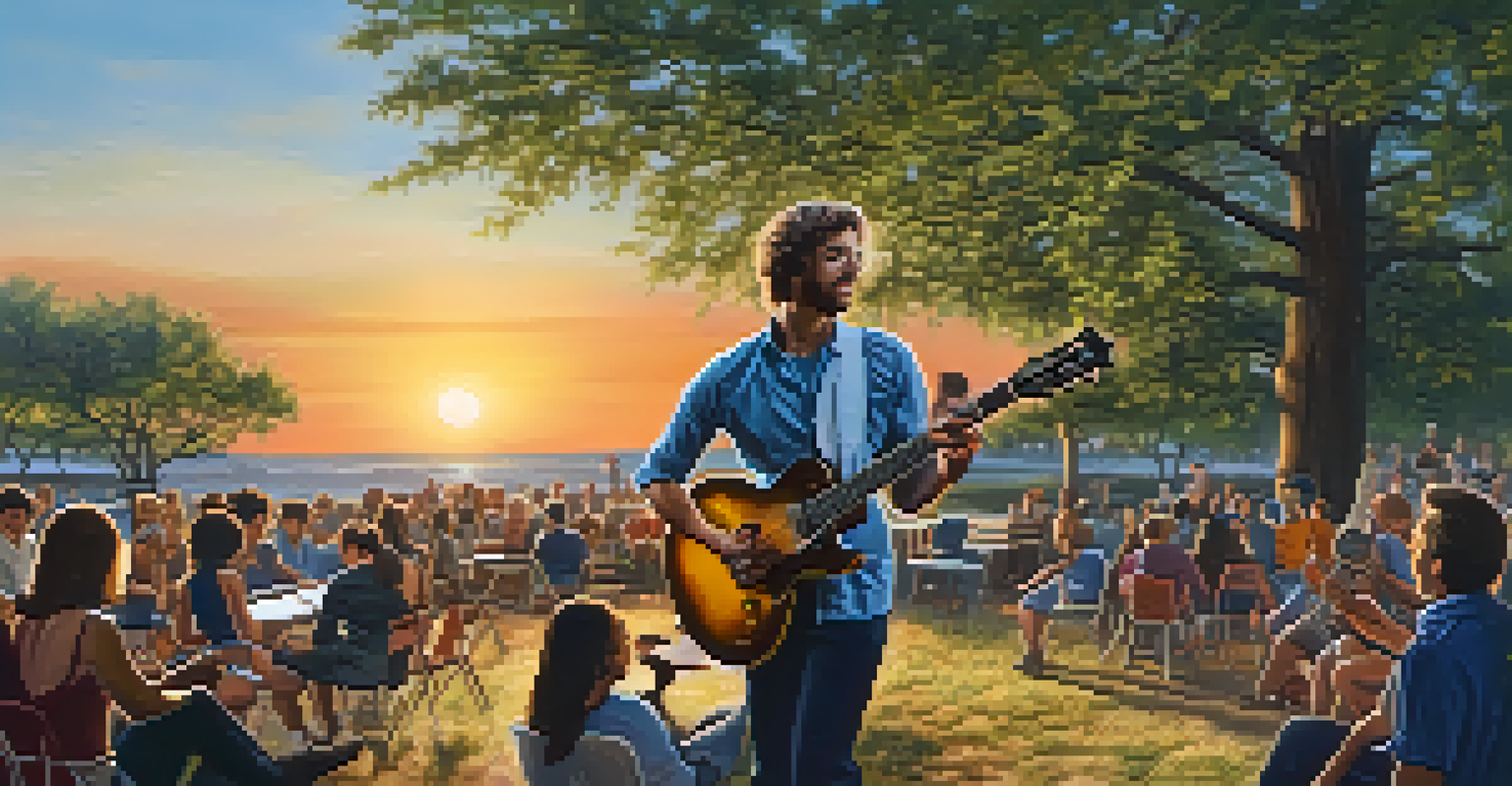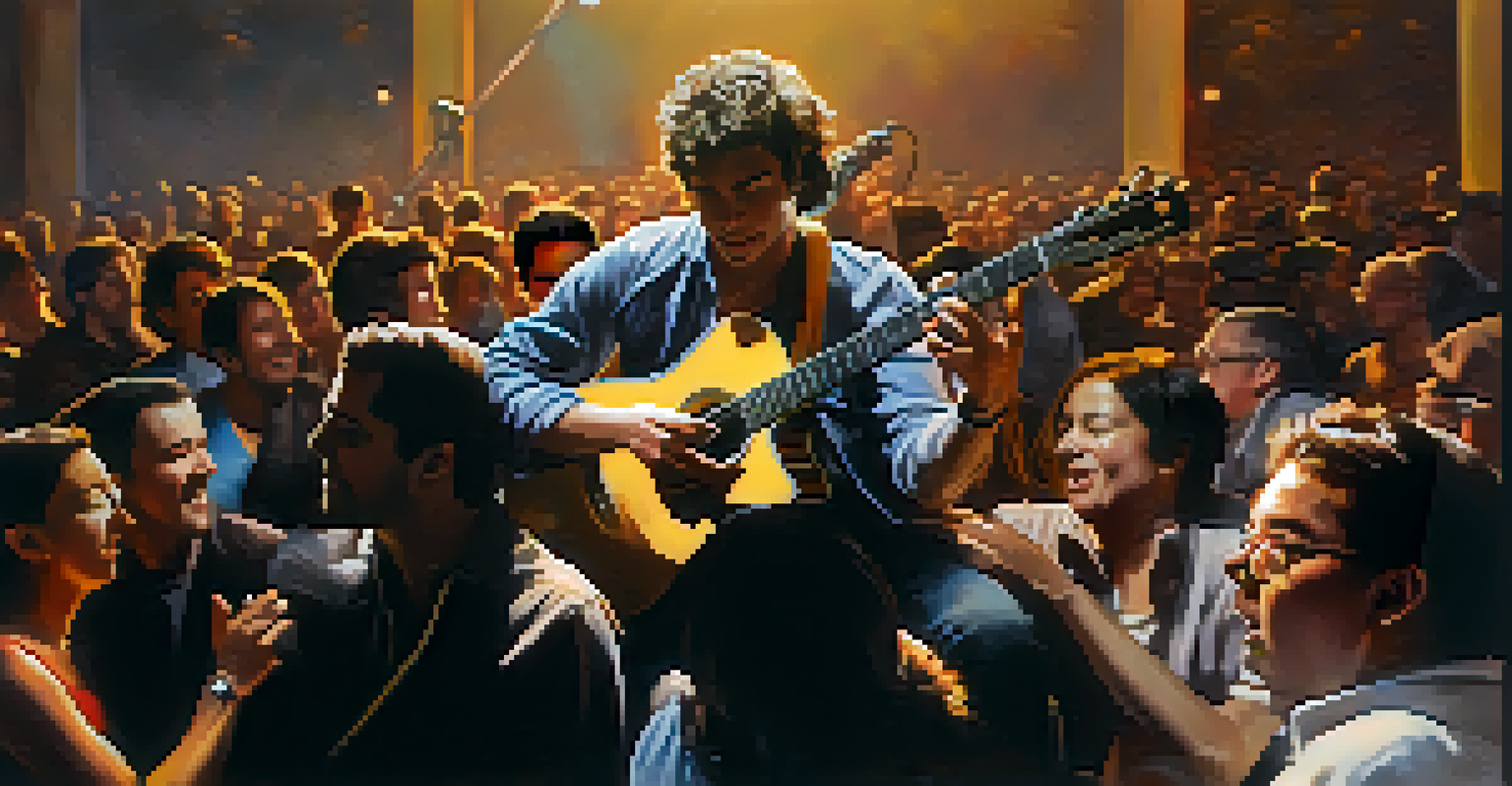The Role of Rhythm in Enhancing Your Guitar Stage Presence

Understanding Rhythm: The Foundation of Musical Expression
Rhythm is the heartbeat of music, acting as the framework that supports melodies and harmonies. It’s the pattern of sounds and silences that gives music its flow and energy. Understanding rhythm allows you to convey emotions effectively, making your performance more engaging.
Rhythm is the pulse of music, the heartbeat that drives the melody forward.
For guitarists, rhythm isn't just about keeping time; it's about creating a groove that resonates with the audience. Think of rhythm as the pulse of your performance—without it, your music may feel lifeless. By mastering rhythm, you can enhance your musical storytelling and captivate listeners.
Consider how a simple rhythm can turn a mundane song into a show-stopper. Just like a well-timed joke can light up a room, a solid rhythm can elevate your performance, drawing your audience in and making them feel every note.
The Power of Timing: Creating Anticipation on Stage
Timing is crucial when playing guitar live; it shapes the dynamics of your performance. By playing slightly ahead or behind the beat, you can create tension and release, keeping your audience on the edge of their seats. This sense of anticipation can be a powerful tool to enhance the emotional impact of your music.

Think about the excitement that builds when a drummer holds back just before a big fill. As a guitarist, you can use similar techniques to create moments that grab attention. By playing with timing, you can turn a simple strum into a captivating moment that lingers in the minds of your audience.
Rhythm is Key to Musical Emotion
Mastering rhythm enhances your ability to convey emotions, making your performance more engaging and dynamic.
Incorporating pauses or rests into your playing can also heighten the overall effect of your performance. These moments of silence allow the audience to absorb what they just heard, making the next note or chord even more impactful.
Groove: The Secret Sauce to Engage Your Audience
Groove is often described as the 'feel' of the music, and it’s essential for connecting with your audience. When you lock into a groove, you create a shared experience that encourages listeners to move, dance, or simply vibe along with you. This connection can elevate your stage presence from good to unforgettable.
Music is the shorthand of emotion.
As a guitarist, it's important to find your unique groove, whether it's a laid-back swing or an energetic rock pulse. When you feel the groove, your body naturally moves in rhythm, which can be contagious for the audience. They are more likely to engage with your performance if they can see how much fun you’re having.
Consider the great guitarists who are known for their grooves—think of legends like Jimi Hendrix or Stevie Ray Vaughan. Their ability to create a compelling groove not only showcases their technical skills but also invites the audience to join in on the musical journey.
Syncopation: Adding Spice to Your Performance
Syncopation is a rhythmic technique that involves placing emphasis on unexpected beats or off-beats. This can add a layer of complexity and excitement to your playing, capturing the audience's attention. By incorporating syncopation into your guitar solos or riffs, you can create a more dynamic performance.
For example, think of how jazz musicians use syncopation to keep their audience engaged. By playing off the expected rhythm, they create an unpredictable and thrilling experience. As a guitarist, you can adopt this technique to showcase your creativity and keep your audience guessing.
Timing Creates Audience Anticipation
Playing with timing allows you to build tension and release, captivating your audience and enhancing the emotional impact of your music.
While syncopation can be intricate, it’s important to practice it slowly at first. Once you’re comfortable, you’ll find that it enhances your stage presence by making your performances more lively and captivating.
Body Language: The Visual Component of Rhythm
Your body language can speak volumes about your connection to rhythm. When you play with confidence and groove, your movements can enhance the overall musical experience. Think of your body as an extension of your instrument; every sway, nod, or step can amplify the music you’re creating.
Imagine a guitarist on stage, locked into an infectious rhythm, who moves with the music. The audience can’t help but be drawn in. If you embody the rhythm with your body, you create a visual representation of the music that resonates with those watching.
Pay attention to how you interact with your guitar and the space around you. Engaging your body in rhythm not only elevates your performance but also encourages the audience to connect with you on a deeper level.
Practice Makes Perfect: Developing Your Rhythmic Skills
To truly harness the power of rhythm, consistent practice is essential. Spend time focusing on different rhythmic patterns and techniques, such as strumming variations, fingerpicking styles, and syncopation. The more you practice, the more naturally these elements will flow into your performances.
Consider using a metronome to help build your timing and precision. Practicing with a metronome can ensure you stay on beat and develop a strong sense of rhythm. Over time, you’ll find that this practice will translate into a more confident and engaging stage presence.
Groove Connects You with Listeners
Finding your unique groove can create a shared experience with the audience, elevating your stage presence and making your performance unforgettable.
Don’t forget to record yourself during practice sessions. Listening back can provide valuable insights into your rhythmic feel and help identify areas for improvement. With dedication and focus, you’ll see a marked difference in your rhythm and overall performance.
Bringing It All Together: Creating a Memorable Performance
Once you’ve mastered rhythm, timing, groove, and body language, it’s time to put it all together for a show-stopping performance. The key is to create a seamless blend of these elements, allowing them to enhance each other. When rhythm becomes second nature, you can focus more on connecting with your audience.
Consider your setlist and how you can use rhythm to create flow between songs. Transitioning smoothly from one groove to another can keep your audience engaged and excited. This thoughtful approach will lead to a more cohesive performance that feels polished and professional.

Lastly, remember to have fun! Your enjoyment will resonate with the audience and make your performance even more memorable. When you play with passion and confidence, the rhythm will naturally shine through, creating an experience that your audience will cherish.